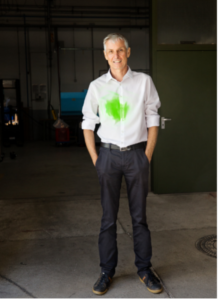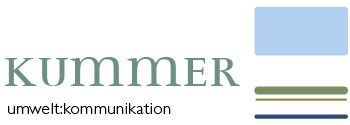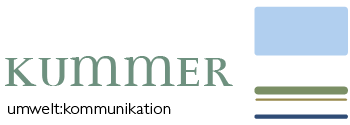22 Mrz „We sort plastics in the same way as we sort letters“
Picture: Polysecure

With Tracer-Based-Sorting, Polysecure wants to improve plastic sorting. The process works by detecting fluorescent markers. In an interview, founder and CEO Jochen Moesslein talks about the advantages of the technology, conceivable business models and the difference to competitor Digimarc.
Tracer-Based-Sorting is a technology that can detect fluorescent markers – so-called tracers – in or on plastics, packaging or labels. When the tracers are excited with laser radiation, they fluoresce in a specific color. The tracers consist of inorganic, harmless powders.
Jochen Moesslein is founder and CEO of the Germany-based company Polysecure. He developed Tracer-Based-Sorting with his team. Moesslein is a physicist and has developed several technology companies in recent years, including a solar collector manufacturer and a biomass company.
Mr. Moesslein, what can Tracer-Based-Sorting do that other sorting methods cannot?
In short, Tracer-Based-Sorting enables higher sorting purity than other processes, regardless of how badly the packaging material is deformed or contaminated. It can also separate food and non-food packaging. You pull the object through a laser curtain and no matter how you pull it through or what condition the material is in, it will be detected.
Which fractions exactly can be sorted out?
In principle, the process is completely open. The circular economy can define which fractions it would like to have, for example a fraction that has to be chemically recycled or a fraction of multilayer packaging or a mono fraction like PET or polyethylene, which is not injection moldable. The market can determine which fractions it wants – and we define the tracers accordingly.
The predominant separation technology to date has beenNIR reflectance spectrometry. Is it no longer sufficient to meet the requirements of industry and commerce?
That depends on the requirements. NIR technology can only be used to detect the common types of plastics such as PE, PP, PS, PET. Beyond this, NIR cannot differentiate the subclasses of main polymers. For example, it is not possible to detect silicone cartridges alone. Silicone cartridges are an impurity in mono streams, for example in the mono stream polyethylene. We have shown in a study that Tracer-Based-Sorting can detect 100 percent of the silicone cartridges.
What grade purity can be achieved with your process?
We reliably achieve 95 to 100 percent detection. This is possible because we sort differently with TBS complete. Conventional processes sort in a cascade, which means that if you have 10 fractions from the yellow bag, you need at least 9 sorting stages because you can only blow off one fraction at each sorting stage. The more fractions to be sorted, the more sorting stages you need and the higher the cost. Our approach, on the other hand, is to first separate the material and then pass it through a detection station. In the detection station, precise tracer recognition, object recognition via artificial intelligence and color recognition take place. Afterwards, the sorted fractions are precisely placed in different containers according to the detected specification of the object. This process is easily scalable – if a fraction is added, an additional container is simply added. Our approach is therefore to organize plastic sorting in the same way as letter or parcel sorting.
Picture: Silke Weinsheimer

How many additional quantities can be sorted as a result?
That is difficult to answer. What we can say is that the fractions will be much purer and better specified, so that the recyclate content can be increased. Up to now, the sorting of recyclable fractions with conventional processes has been well below 50 percent. With our process, we can certainly raise the proportion above 50 percent.
How do the tracers get onto the packaging?
The tracers are simply added to a printing ink and then printed onto the packaging. An area of a few percent of the packaging is sufficient.
The manufacturers would have to be prepared to do this. Why should they do this?
Because they have an interest in a good, consistent quality of recycled material. In addition, the dual systems could offer the brands a bonus scheme for recyclable packaging. According to the Packaging Act, the bonus can be between 10 and 50 euros per ton. So you could refinance the tracer via the bonus. We can also imagine making the tracer available to manufacturers free of charge if we get a share in the financial benefits of the sorting plant operators. In return, the sorting plant achieves a better quality of the recycling material and obtains better prices.
Do the manufacturers show interest?
Yes, they are. This applies, for example, to manufacturers of personal care products, who all use similar plastics. They could get their specific plastic back in different fractions and sorted by color.
There are around 60 packaging sorting plants in Germany. So almost all of them would have to use tracer detection in order to get back sufficiently large quantities. How do you intend to do that?
It certainly won’t happen overnight. But the process could be accelerated if our technology were promoted politically. Precisely because it is an innovative, environmentally friendly process. We see a good opportunity through the new RESAG initiative, which was initiated by Brandenburg and Baden-Württemberg.
What would the conversion of a sorting plant cost?
Basically, the investment per ton throughput of a packaging sorting in Germany is around 300 euros per ton throughput. A complete conversion to our process could be half that, i.e. 150 euros per ton of throughput. Since our process uses eddy current separators and magnetic separators, a significant part of the sorting plant can be left as is. In three to five years, the investment could pay for itself.
Digimarc also offers a detection process for LVP. What is the difference between this method and yours?
The fluorescence we use is a direction-independent signal. This means that the packages do not have to be aligned. The contamination of the material also hardly affects the fluorescence. It gets through even a layer of dust and dirt if the laser curtain is sufficiently strong. Deformation is also not a problem for us. A watermark, like the one Digimarc uses, is a 2D image optical detection that measures small color value differences in specific pixels. This works well when you put the new milk carton on the checkout conveyor, but if the milk bottle is dusted or crushed, you already can’t measure that reliably. This can be improved somewhat and redundancy created by printing all packaging completely with the watermark. But is such a process still ecological if it requires many tons of printing ink?
Is Tracer-Based-Sorting only applicable for packaging, or also for other plastics?
The process works just as well for other plastics, such as engineering plastics from end-of-life vehicles or waste electrical equipment. Take a washing machine, for example: in a typical washing machine there are about 12 to 14 kilograms of plastics, mainly polypropylene, which are vibration-damping, very highly functionalized and contain certain fillers. The polypropylene subclasses can only reuse them for this purpose. Currently there is no recycling process for that, it’s all incinerated. We can sort the plastics into all relevant specifications or subclasses if the washing machine is roughly shredded beforehand.
Have you already presented this to the industry?
Yes, we are in joint development with one of the world’s largest manufacturers on this. I can’t say any more than that at this point.
source: www.320grad.de




No Comments